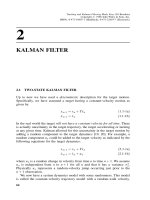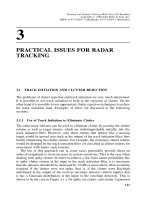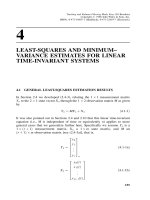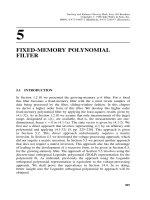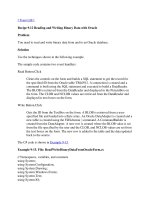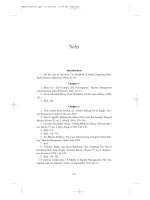Tài liệu Tracking and Kalman filtering made easy P13 pdf
Bạn đang xem bản rút gọn của tài liệu. Xem và tải ngay bản đầy đủ của tài liệu tại đây (131.06 KB, 17 trang )
13
GRAM–SCHMIDT ORTHONORMAL
TRANSFORMATION
13.1 CLASSICAL GRAM–SCHMIDT ORTHONORMAL
TRANSFORMATION
The Gram–Schmidt orthonormalization procedure was introduced in Section
4.3 in order to introduce the orthonormal transformation F applied to the
matrix T. The Gram–Schmidt orthonormalization procedure described there
is called the classical Gram–Schmidt (CGS) orthogonilization procedure.
The CGS procedure was developed in detail for the case s ¼ 3, m
0
¼ 2,
and then these results were extrapolated to the general case of arbitrary s
and m
0
. In this section we shall develop the CGS procedure in greater
detail.
The CGS procedure is sensitive to computer round-off errors. There is a
modified version of the Gram-Schmidt procedure that is not sensitive to
computer round-off errors. This is referred to as the modified Gram–Schmidt
(MGS). After developing the general CGS results, we shall develop the
MGS procedure. One might ask why explain the CGS procedure at all. It is
better to start with a description of the CGS procedure because, first, it is
simpler to explain, second, it makes it easier to obtain a physical feel for
the Gram–Schmidt orthogonalization, and third, it provides a physical feel
for its relationship to the Householder and in turn Givens transformations.
Hence, we shall first again start with a description of the CGS procedure.
As described in Section 4.3, starting with the m
0
þ 1 vectors t
1
; t
2
; ...; t
m
0
þ1
,
we transform these to m
0
þ 1 orthogonal vectors, which we designate as
q
0
1
; q
0
2
; ...; q
0
m
0
þ1
. Having this orthogonal set, the desired orthonormal set
of Section 4.3 (see Figure 4.3-1) can be obtained by dividing q
0
i
by its
magnitude k q
0
i
k to form q
i
: We start by picking the first vector q
0
1
equal to t
1
,
322
Tracking and Kalman Filtering Made Easy. Eli Brookner
Copyright # 1998 John Wiley & Sons, Inc.
ISBNs: 0-471-18407-1 (Hardback); 0-471-22419-7 (Electronic)
that is
q
0
1
¼ t
1
ð13:1-1Þ
At this point the matrix
T
0
¼½t
1
t
2
ÁÁÁ t
m
0
þ1
ð13:1-2Þ
can be thought of as being transformed to the matrix
T
0
ð1Þ
¼½q
0
1
t
2
ÁÁÁ t
m
0
þ1
ð13:1-3Þ
Next q
0
2
is formed by making it equal to t
2
less its component along the
direction of q
0
1
. From (4.2-41) it follows that the vector component of t
2
along
t
1
, or equivalently q
0
1
, is given by
t
2c
¼
ðq
0T
1
t
2
Þq
0
1
q
0T
1
q
0
1
ð13:1-4Þ
Let
r
0
12
¼
ðq
0T
1
t
2
Þ
q
0T
i
q
0
1
ð13:1-5Þ
Then (13.1-4) becomes
t
2c
¼ r
0
12
q
0
1
ð13:1-6Þ
In turn
q
0
2
¼ t
2
À t
2c
ð13:1-7Þ
or
q
0
2
¼ t
2
À r
0
12
q
0
1
ð13:1-8Þ
At this point T
0
can be thought of as being transformed to
T
0
ð2Þ
¼½q
0
1
q
0
2
t
3
ÁÁÁ t
m
0
þ1
ð13:1-9Þ
Next q
0
3
is formed by making it equal to t
3
, less the sum of its two com-
ponents along the directions of the first two orthogonal vectors q
0
1
and q
0
2
. Using
(4.2-41) again yields that the component of t
3
along q
0
1
and q
0
2
is given by
t
3c
¼
ðq
0 T
1
t
3
Þq
0
1
q
0 T
1
q
0
1
þ
ðq
0 T
2
t
3
Þq
0
2
q
0 T
2
q
0
2
ð13:1-10Þ
CLASSICAL GRAM–SCHMIDT ORTHONORMAL TRANSFORMATION
323
In general let
r
0
ij
¼
q
0T
i
t
j
q
0T
i
q
0
i
ð13:1-11Þ
for j > i > 1. Then (13.1-10) can be written as
t
3c
¼ r
0
13
q
0
1
þ r
0
23
q
0
2
ð13:1-12Þ
In turn q
0
3
becomes
q
0
3
¼ t
3
À t
3c
ð13:1-13Þ
or
q
0
3
¼ t
3
À r
0
13
q
0
1
À r
0
23
q
0
2
ð13:1-14Þ
At this point T
0
can be thought of as being transformed to
T
ð3Þ
¼½q
0
1
q
0
2
q
0
3
t
4
ÁÁÁ t
m
0
þ1
ð13:1-15Þ
The formation of q
0
4
; q
0
5
; ...; q
0
m
0
þ1
follows the same procedure as used above to
form q
0
1
, q
0
2
, and q
0
3
. As a result it is easy to show that, for j > 2,
q
0
j
¼ t
j
À
X
jÀ1
i¼1
r
0
ij
q
0
i
ð13:1-16Þ
and after the ðm
0
þ 1Þst step T
0
is given by
T
0
m
0
þ1
¼½q
0
1
q
0
2
ÁÁÁ q
0
m
0
þ1
¼Q
0
ð13:1-17Þ
For simplicity, for now let us assume m
0
¼ 2. Doing this makes it easier to
develop the results we seek. The form of the results obtained using m
0
¼ 2
apply for the general case of arbitrary m
0
to which the results can be easily
generalized. From (13.1-1), (13.1-8) and (13.1-14) it follows that
t
1
¼ q
0
1
ð13:1-18aÞ
t
2
¼ r
0
12
q
0
1
þ q
0
2
ð13:1-18bÞ
t
3
¼ r
0
13
q
0
1
þ r
0
23
q
0
2
þ q
0
3
ð13:1-18cÞ
We can rewrite the above equations in matrix form as
½ t
1
t
2
t
3
¼½q
0
1
q
0
2
q
0
3
1 r
0
12
r
0
13
01r
0
23
00 1
2
4
3
5
ð13:1-19Þ
324
GRAM–SCHMIDT ORTHONORMAL TRANSFORMATION
where it should be emphasized that the matrix entries t
i
and q
0
1
are themselves
column matrices. In turn, the above can be rewritten as
T
0
¼ Q
0
R
0
ð13:1-20Þ
where T
0
is given by (13.1-2), Q
0
is given by (13.1-17), and for m
0
¼ 2
R
0
¼
1 r
0
12
r
0
13
01r
0
23
00 1
2
4
3
5
ð13:1-21Þ
We can orthonormalize Q by dividing each orthogonal vector q
0
i
by its
magnitude k q
0
i
k to form the unitary vector q
i
q
i
¼
q
0
i
k q
0
i
k
ð13:1-22Þ
and in turn obtain
Q ¼½q
1
q
2
ÁÁÁ q
m
0
þ1
ð13:1-23Þ
Let the magnitudes of the q
0
i
be given by the diagonal matrix
D
0
¼ Diag ½k q
0
1
k; k q
0
2
k; ...; k q
0
m
0
þ1
k ð13:1-24Þ
It is easy to see that Q is obtained by postmultiplying Q
0
by D
À1
0
. Thus
Q ¼ Q
0
D
À1
0
ð13:1-25Þ
Using (13.1-24) it follows that (13.1-20) can be written as
T
0
¼ Q
0
D
À1
0
D
0
R
0
ð13:1-26Þ
which on using (13.1-25) becomes
T
0
¼ QR ð13:1-27Þ
where
R ¼ D
0
R
0
ð13:1-27aÞ
Substituting (13.1-24) and (13.1-21) into (13.1-27a) yields
R ¼
k q
0
1
k r
00
12
r
00
13
0 k q
0
2
k r
00
23
00k q
0
3
k
2
6
6
6
4
3
7
7
7
5
ð13:1-28Þ
CLASSICAL GRAM–SCHMIDT ORTHONORMAL TRANSFORMATION
325
where
r
00
ij
¼ r
0
ij
k q
0
i
kð13:1-28aÞ
Using (13.1-11) yields
r
00
ij
¼
q
0T
i
t
j
q
0T
i
q
0
i
k q
0
i
kð13:1-29Þ
which becomes
r
00
ij
¼ q
T
i
t
j
ð13:1-30Þ
for j > i > 1.
Multiplying both sides of (13.1-27) by Q
T
yields
Q
T
T
0
¼ R ð13:1-31Þ
where use was made of the fact that
Q
T
Q ¼ I ð13:1-32Þ
which follows because the columns of Q are orthonormal. In the above Q is an
s Âðm
0
þ 1Þ matrix and I is the ðm
0
þ 1ÞÂðm
0
þ 1Þ identity matrix. Because
also the transformed matrix R is upper triangular, see (13.1-28), we obtain the
very important result that Q
T
is the desired orthonormal transformation matrix
F of (10.2-8) or equivalently of (12.2-6) for the matrix T
0
, that is,
F ¼ Q
T
ð13:1-33Þ
Strictly speaking Q
T
should be a square matrix to obey all the properties of an
orthonormal matrix F given by (10.2-1) to (10.2-3). In fact it is an s Âðm
0
þ 1Þ
matrix. This problem can be readily remedied by augmenting Q
T
to include the
unit vectors q
m
0
þ2
to q
s
when s > m
0
þ 1, where these are orthonormal vectors
in the s-dimensional hyperspace of the matrix T
0
. These vectors are orthogonal
to the ðm
0
þ 1Þ-dimensional column space of T
0
spanned by the m
0
þ 1 vectors
q
1
to q
m
0
þ1
. Thus to form F, Q of (13.1-23) is augmented to become
Q ¼½q
1
q
2
ÁÁÁ q
m
0
þ1
q
m
0
þ2
ÁÁÁ q
s
ð13:1-34Þ
The matrix Q
0
is similarly augmented to include the vectors q
0
m
0
þ2
to q
0
s
. Also
the matrix D
0
is augmented to include s À m
0
À 1 ones after the ðm
0
þ 1Þst
terms. It shall be apparent, shortly, if it is not already apparent, that the vectors
q
m
0
þ2
to q
s
actually do not have to be determined in applying the Gram–
Schmidt orthonormalization procedures. Moreover, the matrices Q, Q
0
, and D
0
do not in fact have to be augmented.
326
GRAM–SCHMIDT ORTHONORMAL TRANSFORMATION
For arbitrary m
0
and s ! m
0
, it is now easy to show that R of (13.1-28)
becomes (12.2-6) with Y
0
3
¼ 0. Hence, in general, (13.1-31) becomes the
desired upper triangular form given by (12.2-6) with Y
0
3
¼ 0, that is,
R ¼ Q
T
T
0
¼
U
----
0
----
0
2
6
6
6
6
4
|fflffl{zfflffl}
m
0
j
j
j
j
j
Y
0
1
-----
Y
0
2
-----
0
3
7
7
7
7
5
|fflfflffl{zfflfflffl}
1
gm
0
g1
gs À m
0
À 1
ð3:1-35Þ
For our m
0
¼ 2 example of (13.1-28) and Section 4.3 [see (4.3-12) and (4.3-24)
to (4.3-29a)]
R ¼
kq
0
1
k r
00
12
r
00
13
0 kq
0
2
k r
00
23
00kq
0
3
k
2
4
3
5
¼
u
11
u
12
y
0
1
0 u
22
y
0
2
00y
0
3
2
4
3
5
ð13:1-36Þ
u
11
¼kq
0
1
kð13:1-37aÞ
u
12
¼ r
00
12
ð13:1-37bÞ
u
22
¼kq
0
2
kð13:1-37cÞ
y
0
1
¼ r
00
13
ð13:1-37dÞ
y
0
2
¼ r
00
23
ð13:1-37eÞ
y
0
3
¼kq
0
3
kð13:1-37fÞ
Because the bottom s À m
0
À 1rowsofR are zero, we can drop these rows in
R above. This would be achieved if we did not augment Q. However, even
though in carrying out the Gram–Schmidt procedure we do not have to
augument Q; Q
0
; and D
0
; for pedagogic reasons and to be consistent with our
presentations in Section 4.3 and Chapters 10 to 12, in the following we shall
consider these matrices as augmented.
From (13.1-27a)
R
0
¼ D
À1
0
R ð13:1-38Þ
Thus, we have that, in general, for arbitrary s > m
0
,
R
0
¼
U
0
----
0
----
0
2
6
6
6
6
4
|fflffl{zfflffl}
m
0
j
j
j
j
j
Y
00
1
-----
1
-----
0
3
7
7
7
7
5
|fflfflffl{zfflfflffl}
1
gm
0
g1
gs À m
0
À 1
ð3:1-39Þ
CLASSICAL GRAM–SCHMIDT ORTHONORMAL TRANSFORMATION
327




